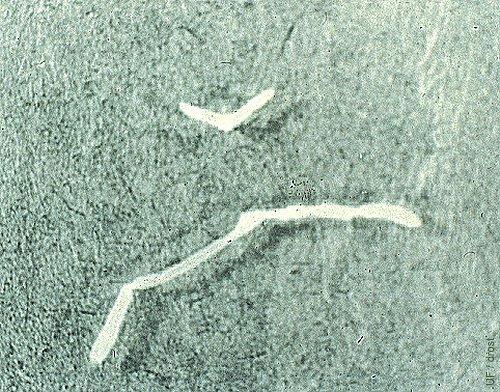
Day 14 Bovine Conceptuses.
The upper V-shaped conceptus is a normal Day 14 bovine conceptus (length 3.8 mm). The lower, longer (37.3 mm) conceptus is a Day 14 bovine conceptus from a cow treated with supplemental progesterone.
Geisert R (1983)

Day 19 Conceptus.
This long filamentous bovine conceptus was collected at slaughter from a cow known to be inseminated 19 days previously. The inner cell mass can be identified as a thicker, darkened area in the upper lefthand corner of the image.
Drost M (1988)
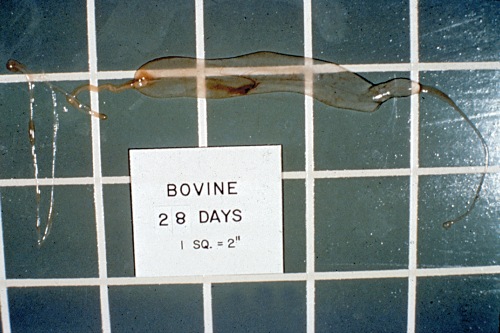
Day 28 Conceptus.
Long filamentous conceptus which extends throughout the entire lumen of the uterus. The darker area near the center is the early embryonic mass. [5 cm squares]
Chenoweth PJ (2012)
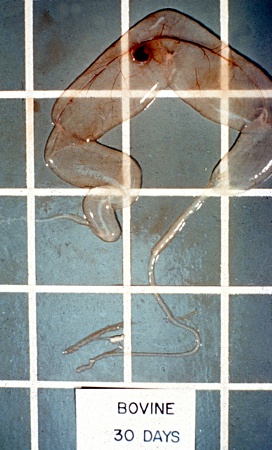
Day 30 Conceptus.
Long filamentous conceptus which extends throughout the entire lumen of the uterus. The darker area near the center is the early embryonic mass. Note the early placental blood supply in the allantois. [5 cm squares]
Chenoweth PJ (2012)

Day 40 Conceptus.
The embryo proper is surrounded by the amniotic vesicle which in turn is enclosed in the allantois. [5 cm squares]
Chenoweth PJ (2012)
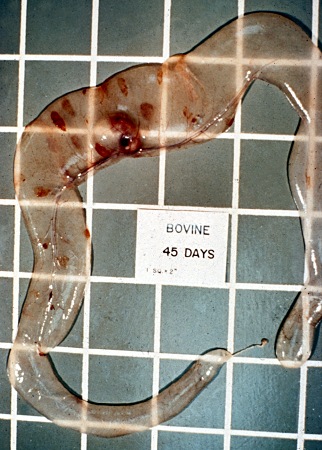
Day 45 Conceptus.
The embryo proper is surrounded by the amniotic vesicle (4.5 cm) which in turn is enclosed in the allantois. Cotyledons are developing on the external surface of the allantoic membranes. They tend to be largest near the amnion where the blood supply is the most developed. [5 cm squares]
Chenoweth PJ (2012)
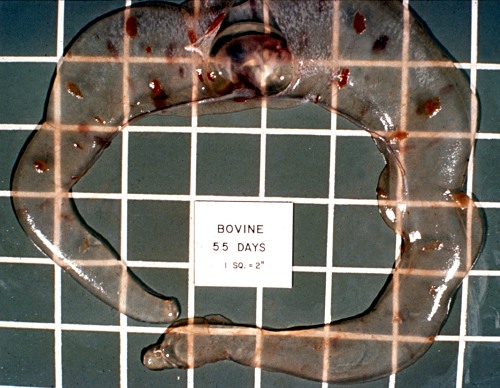
Day 55 Conceptus.
The amniotic vesicle (6.5 cm) is enclosed by the allantois. Cotyledons are developing in 4 rows of 15 on the external surface of the allantoic membranes. They tend to be largest near the amnion where the blood supply is the most developed. [5 cm squares]
Chenoweth PJ (2012)
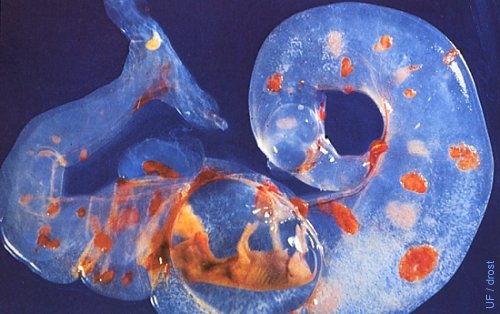
Day 55 Bovine Conceptus.
The chorio-allantois has been removed over the amniotic vesicle (6.5 cm)to expose the little fetus.
Drost M (1982)
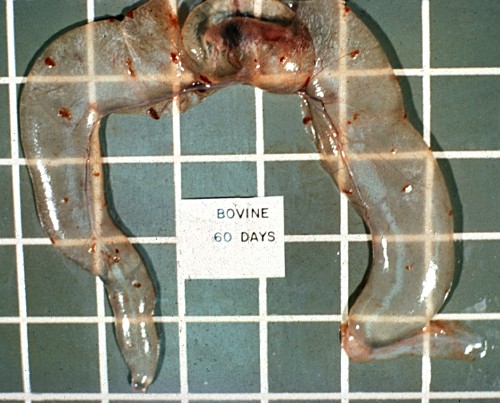
Day 60 Conceptus.
The amniotic vesicle (6.5 cm) has become less turgid and a mouse-size fetus can now be palpated. [5 cm squares]
Chenoweth PJ (2012)
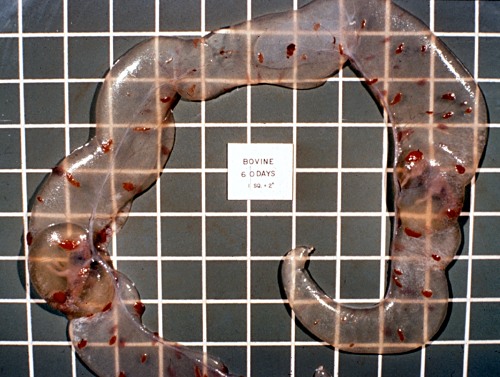
Day 60 Twin Conceptuses.
The amniotic vesicles (6.5 cm) have become less turgid and a mouse-size fetus can now be palpated in each horn. [5 cm squares]
Chenoweth PJ (2012)
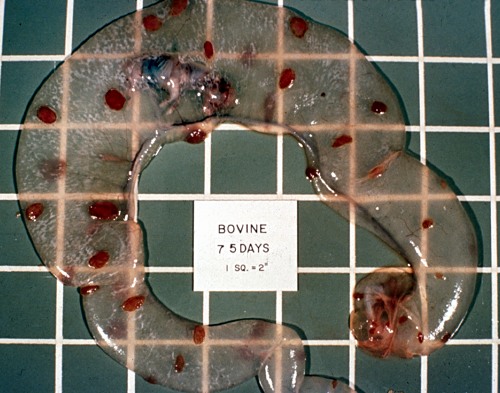
Day 75 Conceptus.
The flaccid amniotic vesicle allows the palpation of a large mouse-size fetus at 2.5 months of gestation. The cotyledons continue to develop in 4 rows of 15 per horn for a total of 120 throughout the uterus. [5 cm squares]
Chenoweth PJ (2012)
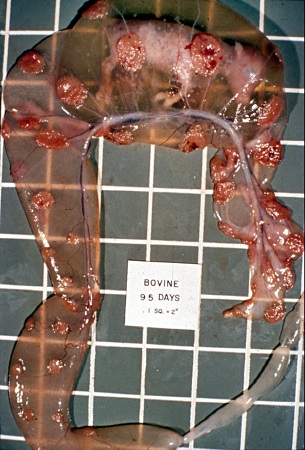
Day 95 Conceptus.
The flaccid amniotic vesicle contains a palpable large rat-size fetus. The fetal head measures 6.5 cm from the tip of the nose to the forehead. [5 cm square]
Chenoweth PJ (2012)
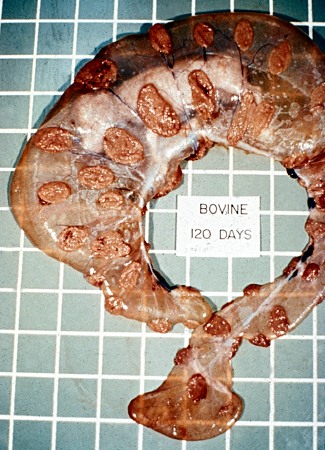
Day 120 Conceptus.
The fetus is the size of a small cat at 4 months of gestation. [5 cm squares]
Chenoweth PJ (2012)
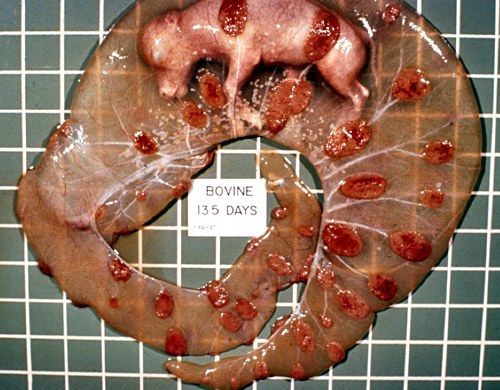
Day 135 Conceptus.
The fetus is the size of a cat at 4.5 months of gestation. The cotyledons, arranged in 4 rows of 15 per horn, are largest near the optimal blood supply along the lesser curvature and nearest the umbilical cord attachment. [5 cm squares]
Chenoweth PJ (2012)
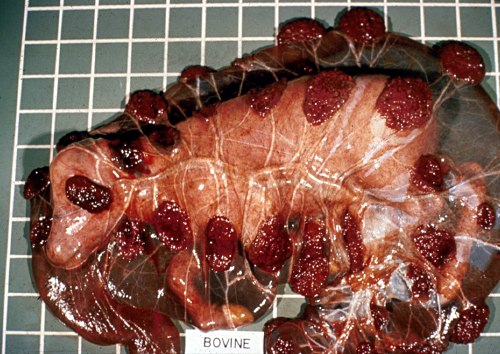
Day 135 Conceptus - Close-up
The fetus is the size of a cat at 4.5 months of gestation. The cotyledons, arranged in 4 rows of 15 per horn, are largest near the optimal blood supply, along the lesser curvature, and nearest the umbilical cord attachment. [5 cm squares]
Chenoweth PJ (2012)
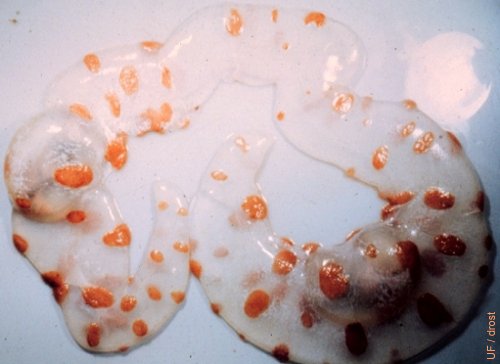
Twin Conceptuses.
Two, approximately 55-day, bicornual amniotic vesicles are shown. If there are two corpora lutea present the twins are most likely fraternal. If there is only one corpus luteum, the fetuses are identical.
Drost M (1982)
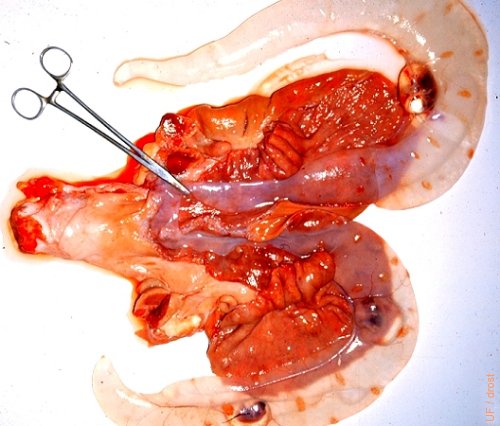
Triplet Conceptuses.
Three, approximately 50-day, amniotic vesicles are present. The vesicle near the tip of the right horn appears somewhat smaller which could be due to limited blood supply. The chorio-allantoic space is continuous. Depending on the sex of the embryos, freemartinism should be considered.
Drost M (1982)
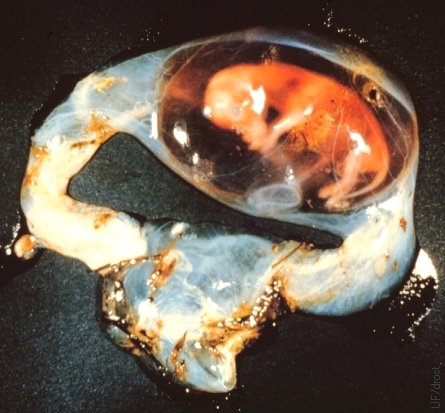
First Trimester Abortion.
Abortion at 2.5 months. Cause of abortion was undetermined. Could be iatrogenic, after Prostaglandin F2alpha injection.
Drost M (1982)

2.5-Month Conceptus.
The chorio-allantoic membranes have been removed over the amniotic vesicle. Even visually, it can be appreciated that the vesicle has become slightly flaccid. The small cotyledons are also readily visible.
Drost M (1982)

Normal 70-day Conceptus.
The 70-day fetus is located in the right horn. The scissors point at the area of the body of the uterus. The linear arrangement of the four rows of cotyledons is readily identifiable. There are approximately 15 cotyledons per row per horn, for a total of approximately 120.
Drost M (1982)
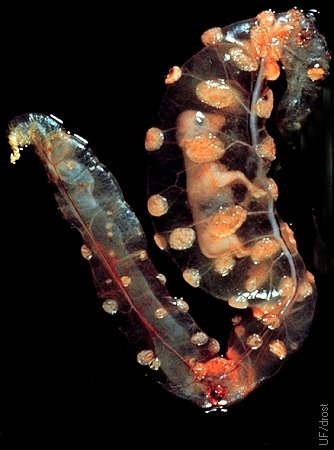
Normal 80-day Conceptus.
The 80-day fetus, located in the right horn, is the size of a small rat. The cotyledonary placenta is nicely outlined by the four rows of cotyledons. The individual cotyledonary arteries and veins converge along the lesser curvature of the uterus to connect with the umbilical vessels.
Drost M (1982)
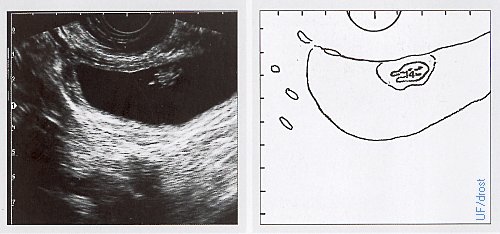
Day 27 Embryo / Ultrasound.
The amniotic vesicle is oblong. A heart beat can be detected at this time. Legend: 14 = trunk.
Pieterse MC (1999)
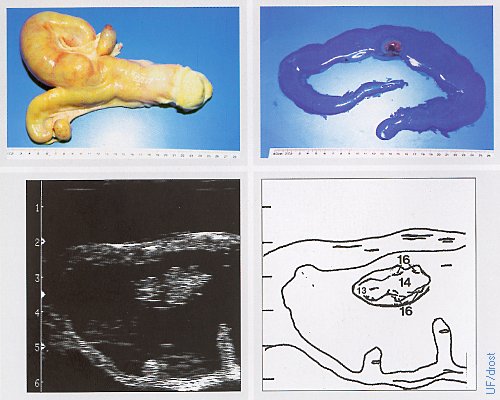
Day 37 Conceptus / Ultrasound.
The size of the amniotic vesicle is about 1 cm. The fetal heartbeat is readily detectable. Legend: 13 = head, 14 = trunk, 16 = limbs.
Pieterse MC (1999)
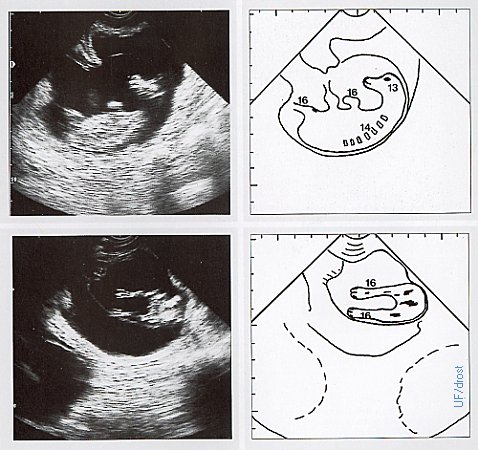
Day 59 Fetus / Ultrasound.
The fetus is the size of a small mouse. The amniotic vesicle is beginning to slacken allowing the fetus to be recognized by feel. Legend: 13 = head, 14 = trunk, 16 = limbs.
Pieterse MC (1999)
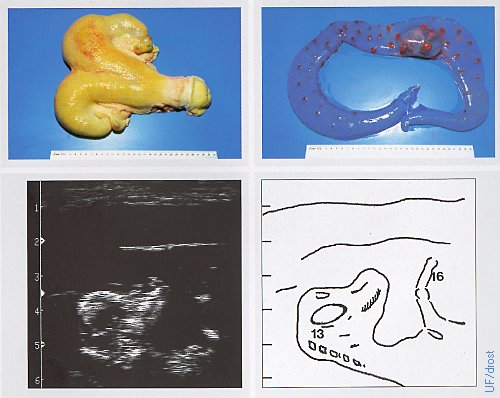
Day 60 Conceptus / Ultrasound.
The fetus is the size of a mouse. The amniotic vesicle is losing its turgidity allowing the fetus to be felt directly by palpation. Legend: 13 = head, 16 = limbs.
Pieterse MC (1999)
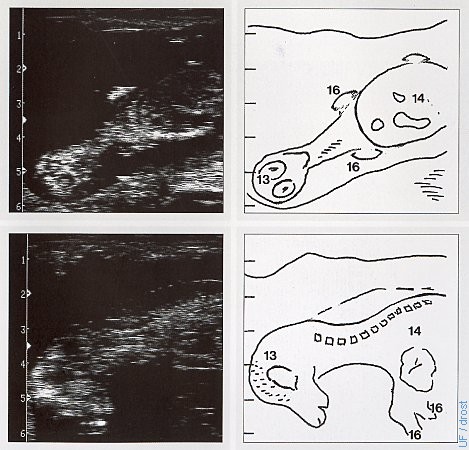
Day 61 Conceptus / Ultrasound.
The mouse-size fetus can be recognized by palpation per rectum at this stage. Legend: 13 = head, 14 = trunk, 16 = limb.
Pieterse MC (1999)
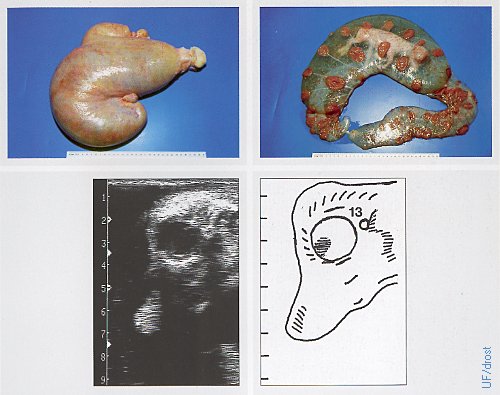
Day 105 Fetal Head / Ultrasound.
The head of the fetus measures between 100 and 110 mm from the tip of the nose to the center of the forehead. Legend: 13 = head.
Pieterse MC (1999)
